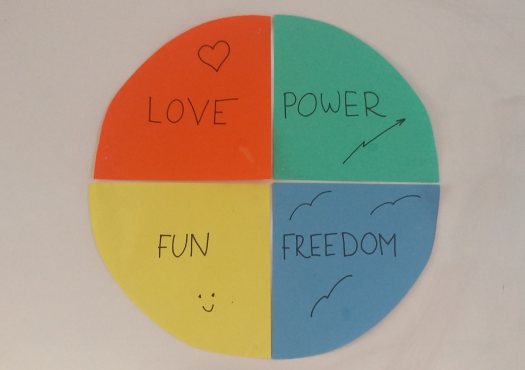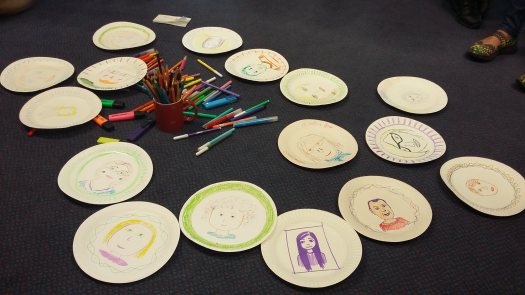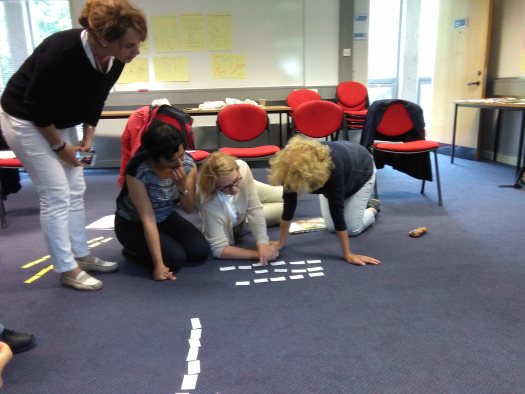Editorial
Csilla Jaray-Benn attended ‘Creative Methodology for the Classroom’ course delivered by Mojca Belak at Pilgrims in 2015. The text first appeared in Teaching Times N°77 2016 by TESOL France www.tesol-france.org
Pilgrims News: Relax, Ask and Relax… - Flashback to a Summer Teacher Training Course at Pilgrims
Csilla Jaray-Benn, France
Csilla Jaray-Benn is a part-time lecturer in English at the University Grenoble Alpes, designs and runs business English training courses at her own training organization, Business English Services, is a regular conference speaker, the President of TESOL France and regional coordinator for Grenoble. She is member of the Creativity Group and was invited speaker at Pilgrims for the summer. E-mail: csilla.benn@bes-grenoble.com, www.bes-grenoble.com
Menu
About Pilgrims
Our course
We learned creative activities for the classroom
We learned about the other person
We learned about ourselves
As teachers, we all count the days till the end of the school year to finally be able to recharge our batteries whether on a sunny beach, in the cool mountains or simply by enjoying the idleness of those long summer days with families and friends. But the long summer break can also allow for some time to refill our teaching toolkit and our resources, helping to take some of the pressure off that dreaded first day back. So this is what I decided to do, along with hundreds of other teachers from all parts of Europe who came to the beautiful campus of University of Kent in the historic town of Canterbury to learn, share, and genuinely have fun during a two-week teacher training course run by Pilgrims. Principal, Jim Wright opened the first course of the summer by setting the three rules to follow: relax, ask, and relax. What we accomplished, was ‘active relaxation’ in a stimulating, inspiring, creative and definitely very relaxed environment created for us by trainers and administrative staff at Pilgrims.
I enrolled for the ‘Creative Methodology for the Classroom’ course, run by Mojca Belak, attended by fourteen teachers from all over Europe including Russia, Germany, Slovakia, Italy, Spain, Portugal, the Czech Republic, Poland and France. Most of us were teachers of English as a foreign language but a few group members taught other languages. The carefully scheduled course programme had the right balance of hands-on activities and the theory behind learning, communication and personal development. Discovering such broad theories as Choice Theory, Neuro-linguistic programming (NLP), Multiple Intelligences and Transactional Analysis, helped us see who we are as persons and teachers, and how we can use this knowledge to guide our students to progress with their language skills.
Since its establishment in 1974 by Mario Rinvolucri and James Dixey, Pilgrims has always insisted on the importance of ‘being’. So along these lines, we experienced ‘being’ a learner for two weeks and participating, on average, in 15 different activities per day. Creative activities included ideas to warm-ups, building group dynamics, developing all four skills, addressing different learning styles, or unleashing hidden creativity in our learners. We worked with video and audio materials, songs and fairy tales, we wrote stories, poems, a letter to ourselves, our trainer and even the moon… We also practiced writing using another person’s handwriting, forgetting the anxiety of writing in a different language.

We transformed the often boring dictation into loud laughter and fun when we sat in groups in four different corners of the room and different parts of a text were read simultaneously by a team member from the opposite corner. I can still hear Léna’s (Elena Stolyarova) voice, clearly articulating with gestures, trying to make herself understood by her team who had to screen out the three other voices reading different texts, write down their parts, then re-assemble the text by working together with the other three groups. This activity, called ‘Four voice dictations’, is a good example of how adding a creative twist to a traditional classroom exercise, can turn it into something memorable, personal and create a good, relaxed atmosphere in the classroom.
Mojca welcomed each trainee with a personal letter and an open invitation to reply to her before the course was over. She corresponds with her university students in Slovenia and though it does take time, exchanging letters between teacher and students helps create a positive, relaxed learning environment, as well as improve students’ writing skills.

Of all the numerous activities, invisibly forcing us to focus on the other person - such an important skill in teaching – and on the other person’s problems and difficulties, one stayed with me in particular. Working in pairs, we listened to a personal story of a conflict situation from our partner’s own lives. Our task was then to transform this story into a legend, using elements of the traditional fairy tale and tell it as it was remembered by people centuries afterwards. It was a powerful activity, which can easily be used with teenagers, young adults, not to mention in response to workplace conflicts which surface during a business English lesson.
The Pilgrims approach promises personal development and we most definitely received that. We discovered skills we had never thought we had, or had never been confident about, such as drawing, drawing with the left hand (surprisingly more accurately than with the right) or writing a poem to offer as a gift, or using images related to the five senses. Creativity is a hidden skill in everyone and not always easy to unleash and express, but with a group built on trust, collaboration, genuine attention to the other person, and a relaxed atmosphere, creativity can be brought to the surface in teachers and students alike. We experienced how much performing creative activities collaboratively relieves anxiety as the main obstacle of daring to be creative.
In Peter Dyer’s wonderful workshops and sessions, we learned about our bodies as others see them and became conscious of certain postures through the other person’s eyes. When I’m tired, I think about Peter’s activity – imagining that while we are walking, as opposed to a heavy, ground focused tread, a thin thread is pulling us upwards – and I feel immediately uplifted, optimistic, confident and relaxed! A simple activity like this can change the way we stand in front of the class, during our presentations, in public speaking situations or in every-day life. It helps us become more self-confident as well as convincing.

Out of three theories we covered, it is the Choice Theory that resonated with most people in the group. I found Dr. William Glasser’s ideas particularly helpful for teachers. The main points are as follows: all we do is behave; almost all behavior is chosen; and we are driven by five basic, genetically determined needs, which include survival, love, power, freedom and fun. When we analyze how these needs are satisfied in our various relationships with colleagues, students, family members, we become aware of why certain situations can have such a negative impact on our feelings in general and our performance. In relation to this theory, if there is one reassuring take-away that I have brought home with me from this course on ‘Creative Methodology for the Classroom’ at Pilgrims is that success in learning is 50 per cent the teacher’s responsibility and 50 per cent the student’s responsibility or choice.
We spent two intensive weeks of learning new things and discovering hidden knowledge and skills, complemented by workshops in the afternoon and evening as well as time relaxing in one of the many pubs around Canterbury Cathedral. My overall experience of this course can be summed up by the words of the philosopher Martin Buber: “The only way to learn is by encounters”. Pilgrims is a place of encounters in many ways: encounters with new ideas, practical activities which always place the person at the centre, and most importantly, encounters with like-minded and like-hearted fellow teachers in a relaxed environment.

Please check the Pilgrims courses at Pilgrims website.


|